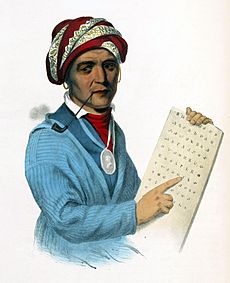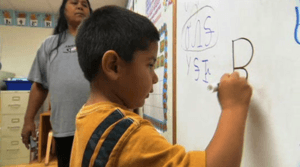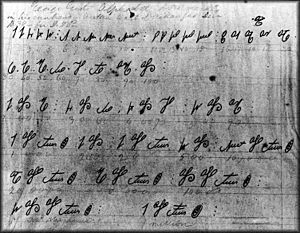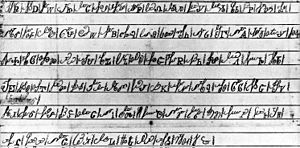Cherokee syllabary facts for kids
Quick facts for kids Cherokee |
|
|---|---|

Tsa-la-gi ("Cherokee") written in the Cherokee syllabary
|
|
| Type | Syllabary |
| Spoken languages | Cherokee language |
| Time period | 1820s – present |
| Unicode range |
|
| ISO 15924 | Cher |
| Note: This page may contain IPA phonetic symbols in Unicode. | |
The Cherokee syllabary is a unique writing system invented by Sequoyah in the early 1820s. He created it so the Cherokee language could be written down. What's amazing is that Sequoyah couldn't read or write any language before he invented his own system! He first tried making a symbol for every word, but that was too hard. So, he changed his idea to create a symbol for each syllable.
His system has 85 characters, and each one stands for a whole syllable, not just a single letter sound. This is different from the English alphabet, where each letter usually makes one sound. Even though some Cherokee symbols look a bit like letters from other alphabets (like Latin or Greek), they don't make the same sounds.
Contents
What is the Cherokee Syllabary?

Each character in the Cherokee syllabary represents one syllable. Think of it like the kana system in Japanese. The first six characters are for single vowel sounds. After that, the characters combine a consonant and a vowel.
A man named Samuel Worcester helped arrange the syllabary in the order we usually see it today. He was very important in getting Cherokee books and newspapers printed starting in 1828.
The chart below shows the syllabary characters. The 'v' sound in the last column is a special nasal vowel sound, like saying 'uh' through your nose.
| The chart below uses Unicode characters from the Cherokee block. For an image alternative, see File:Cherokee Syllabary.svg. | ||||||||||||||||||||
| Consonant | a | e | i | o | u | v [ə̃] | ||||||||||||||
|---|---|---|---|---|---|---|---|---|---|---|---|---|---|---|---|---|---|---|---|---|
| Ø | Ꭰ | Ꭱ | Ꭲ | Ꭳ | Ꭴ | Ꭵ | ||||||||||||||
| g / k | Ꭶ | Ꭷ | Ꭸ | Ꭹ | Ꭺ | Ꭻ | Ꭼ | |||||||||||||
| h | Ꭽ | Ꭾ | Ꭿ | Ꮀ | Ꮁ | Ꮂ | ||||||||||||||
| l | Ꮃ | Ꮄ | Ꮅ | Ꮆ | Ꮇ | Ꮈ | ||||||||||||||
| m | Ꮉ | Ꮊ | Ꮋ | Ꮌ | Ꮍ | Ᏽ* | ||||||||||||||
| n / hn | Ꮎ | Ꮏ | Ꮐ | Ꮑ | Ꮒ | Ꮓ | Ꮔ | Ꮕ | ||||||||||||
| qu [kʷ] |
Ꮖ | Ꮗ | Ꮘ | Ꮙ | Ꮚ | Ꮛ | ||||||||||||||
| s | Ꮝ | Ꮜ | Ꮞ | Ꮟ | Ꮠ | Ꮡ | Ꮢ | |||||||||||||
| d / t | Ꮣ | Ꮤ | Ꮥ | Ꮦ | Ꮧ | Ꮨ | Ꮩ | Ꮪ | Ꮫ | |||||||||||
| dl / tl [d͡ɮ] / [t͡ɬ] |
Ꮬ | Ꮭ | Ꮮ | Ꮯ | Ꮰ | Ꮱ | Ꮲ | |||||||||||||
| ts [t͡s] |
Ꮳ | Ꮴ | Ꮵ | Ꮶ | Ꮷ | Ꮸ | ||||||||||||||
| w [ɰ] |
Ꮹ | Ꮺ | Ꮻ | Ꮼ | Ꮽ | Ꮾ | ||||||||||||||
| y [j] |
Ꮿ | Ᏸ | Ᏹ | Ᏺ | Ᏻ | Ᏼ | ||||||||||||||
| * The character Ᏽ was previously used to represent the syllable mv, but is no longer used. | ||||||||||||||||||||
You might notice that the character Ꮩ (do) looks different in older writings. It used to look like a Greek Λ, but now it looks more like a Latin V. There's also a handwritten style of the syllabary that looks quite different from the printed version.
How are Cherokee Characters Ordered?
The most common way to list the Cherokee characters is from left to right, row by row, just like you read English. This is the order used in computers (Unicode).
Here's the usual order:
- Ꭰ (a), Ꭱ (e), Ꭲ (i), Ꭳ (o), Ꭴ (u), Ꭵ (v)
- Ꭶ (ga), Ꭷ (ka), Ꭸ (ge), Ꭹ (gi), Ꭺ (go), Ꭻ (gu), Ꭼ (gv)
- Ꭽ (ha), Ꭾ (he), Ꭿ (hi), Ꮀ (ho), Ꮁ (hu), Ꮂ (hv)
- Ꮃ (la), Ꮄ (le), Ꮅ (li), Ꮆ (lo), Ꮇ (lu), Ꮈ (lv)
- Ꮉ (ma), Ꮊ (me), Ꮋ (mi), Ꮌ (mo), Ꮍ (mu)
- Ꮎ (na), Ꮏ (hna), Ꮐ (nah), Ꮑ (ne), Ꮒ (ni), Ꮓ (no), Ꮔ (nu), Ꮕ (nv)
- Ꮖ (qua), Ꮗ (que), Ꮘ (qui), Ꮙ (quo), Ꮚ (quu), Ꮛ (quv)
- Ꮜ (sa), Ꮝ (s), Ꮞ (se), Ꮟ (si), Ꮠ (so), Ꮡ (su), Ꮢ (sv)
- Ꮣ (da), Ꮤ (ta), Ꮥ (de), Ꮦ (te), Ꮧ (di), Ꮨ (ti), Ꮩ (do), Ꮪ (du), Ꮫ (dv)
- Ꮬ (dla), Ꮭ (tla), Ꮮ (tle), Ꮯ (tli), Ꮰ (tlo), Ꮱ (tlu), Ꮲ (tlv)
- Ꮳ (tsa), Ꮴ (tse), Ꮵ (tsi), Ꮶ (tso), Ꮷ (tsu), Ꮸ (tsv)
- Ꮹ (wa), Ꮺ (we), Ꮻ (wi), Ꮼ (wo), Ꮽ (wu), Ꮾ (wv)
- Ꮿ (ya), Ᏸ (ye), Ᏹ (yi), Ᏺ (yo), Ᏻ (yu), Ᏼ (yv)
There are also other ways to order the characters, including the one Sequoyah originally used.
Cherokee Numbers: Did Sequoyah Invent Them?
Today, the Cherokee people mostly use the same numbers we do (0-9). However, in the late 1820s, Sequoyah also created his own set of number symbols. These symbols were never widely used or printed.
Sequoyah designed unique symbols for numbers 1 through 19. He also made symbols for "tens" like 20, 30, up to 100. For bigger numbers, he had symbols for thousands and millions. To write a number like 64, you would combine his symbol for 60 with his symbol for 4. For 504, you would use the symbols for 5, 100, and 4.
Recently, in 2012, the Cherokee Language Consortium decided to start using Sequoyah's numbers in some situations. They even added a symbol for zero and for billions and trillions!
The Syllabary's Early History
Around 1809, Sequoyah was amazed by how Europeans could write things down, calling their books "talking leaves." He decided to create a way for the Cherokee language to be written too. He spent twelve years working on it. He tried many ideas and changed many characters before finishing his syllabary.
Once it was ready in the early 1820s, the syllabary became popular very quickly among the Cherokee people. By 1825, most Cherokees could read and write using this new system.
Experts at the time were very impressed. A politician and linguist named Albert Gallatin thought the Cherokee syllabary was even better than the English alphabet for learning to read. He noted that even though Cherokee students had to learn 85 symbols (compared to 26 for English), they could read right away after learning them all. A Cherokee student could learn to read in just a few weeks, while an English student might take two years!
In 1828, Elias Boudinot, a Cherokee writer, changed the order and shapes of some characters to make them easier to print. One character was removed, leaving 85. After these changes, the syllabary was used for the Cherokee Phoenix newspaper and other publications.
Later, in 1834, Samuel Worcester made more changes to improve how easy it was to read Cherokee text. For example, he flipped the 'do' character (Ꮩ) so it wouldn't be confused with the 'go' character (Ꭺ). For a long time, the characters stayed mostly the same until new printing methods came along in the 1900s.
How the Syllabary is Used Today


In the 1960s, the Cherokee Phoenix Press started publishing books in the Cherokee syllabary again. In the 1970s, a special typewriter ball was made for the IBM Selectric machine, allowing people to type in Cherokee.
With computers, it became much easier to write and publish in Cherokee. In 2010, Roy Boney Jr. and Joseph Erb created a special keyboard cover. This helps students at the Cherokee Nation Immersion School type faster, where all their schoolwork is in syllabary.
The syllabary is used in many places today. You can see it in books, newspapers, and on websites. It's even on street signs in places like Tahlequah, Oklahoma and Cherokee, North Carolina. More and more children's books are being printed in Cherokee for students learning the language.
A Possible Link to the Vai Syllabary
In the 1960s, some clues suggested that the Cherokee syllabary might have inspired the Vai syllabary in Liberia, Africa. The Vai syllabary appeared around 1832-1833. At that time, American missionaries were trying to use the Cherokee syllabary as a model to write Liberian languages.
There's also a possible connection through Cherokee people who moved to Liberia after the Cherokee syllabary was invented. One man, Austin Curtis, married into an important Vai family and became a chief. It's interesting that the first time the Vai script was noticed by the world, it was on Curtis's house!
Learning the Cherokee Language

When people start learning Cherokee, they often begin by using Roman letters (like English letters) to write the sounds. Later, they learn the syllabary itself. Many universities and schools offer Cherokee language classes that teach the syllabary. These include Haskell Indian Nations University, Northeastern State University, and immersion schools like New Kituwah Academy.
Cherokee Syllabary and Computers (Unicode)
The Cherokee syllabary was added to the Unicode Standard in 1999. This means that computers and other devices can now show and use Cherokee characters. In 2015, a new update made it possible to have both uppercase and lowercase Cherokee letters, just like in English.
You can find Cherokee fonts on many computers, including macOS and Windows. There are also free Cherokee fonts available, like Digohweli and Noto Sans Cherokee.
See also




